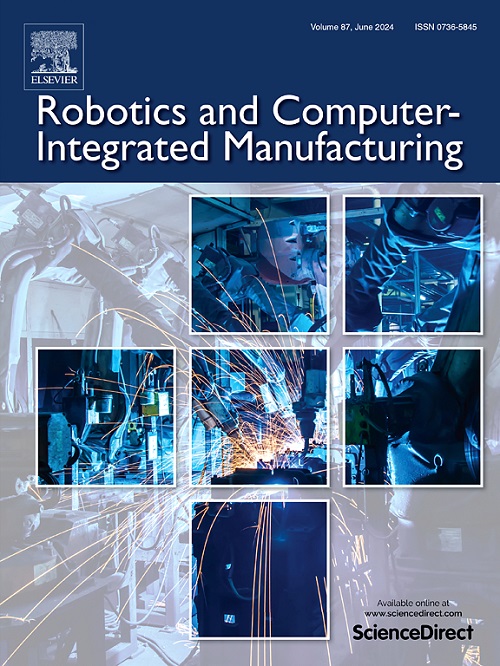薄壁锥形管管内加工机器人的精确定位与环焊缝磨削规划
IF 11.4
1区 计算机科学
Q1 COMPUTER SCIENCE, INTERDISCIPLINARY APPLICATIONS
引用次数: 0
摘要
管道机器人已应用于检测、清洗、焊接、磨削、钻孔等领域,高效、经济地实现了狭小空间的作业。然而,由于机器人加工系统的刚度和精度较低,机器人位置不确定,目标特性一致性差,智能操作仍然是一个问题,特别是对于薄壁锥形管内焊缝的高精度加工。针对这一问题,提出了一种薄壁锥形管道内加工机器人的智能环焊缝磨削方法。设计了一种具有自适应运动能力、刚度可控、加工精度高的管道加工机器人(ipmr - 1),该机器人得益于接触力可控和高精度三轴加工机构的设计。采用基于时间序列点云的焊缝定位方法,结合解析位姿模型对机器人进行自定位,获得机器人相对于焊缝区域的准确位姿。在此基础上,提出了一种具有焊缝边界识别、加工路径生成和优化能力的智能加工路径规划方法,自适应地实现了薄壁锥形管内部焊接不平整(变形、错位等)的高加工质量和安全性。在薄壁锥形管内进行了焊缝磨削实验,验证了所提方法的有效性。结果表明,采用所提出的环焊缝智能磨削方法的ipmr - 1在没有人工干预的情况下完成了自主高质量加工。在不损坏基材的情况下,最大残焊高度为0.18 mm,平均残焊高度控制在0.08 mm左右。本文章由计算机程序翻译,如有差异,请以英文原文为准。
Accurate localization and girth weld grinding planning for an in-pipe machining robot of thin-walled conical pipe
In-pipe robots have been applied to detection, cleaning, welding, grinding, drilling, etc., which realizes the narrow space operation efficiently and economically. However, intelligent operation is still a problem, especially for high-precision machining of inner welds in thin-walled conical pipes, due to the low stiffness and precision of the robot machining system, uncertain robot position, and poor consistency of target characteristics. To address this problem, an intelligent girth weld grinding method of an in-pipe machining robot for thin-walled conical pipes is proposed. An in-pipe machining robot (named IPMR-I) with adaptive motion ability, controllable stiffness, and high machining precision is designed, which benefits by the designs of controllable contact forces and a high-precision three-axis machining mechanism. A weld locating method based on time-series point clouds, combined with an analytical pose model, is used for robot self-localization, obtaining the accurate pose of the robot relative to the weld region. Furthermore, an intelligent machining path planning method is proposed with the abilities of the weld boundary recognition, machining path generation, and optimization, which adaptively realizes the high machining quality and safety facing the welding irregularity (e.g., deformation and misalignment) inside thin-walled conical pipes. Several weld bead grinding experiments were conducted inside thin-walled conical pipes to verify the proposed methods’ validity. The results proved that IPMR-I with the proposed intelligent girth weld grinding method completed autonomous high-quality machining without manual intervention. Without damaging the base material, the maximum residual weld height is 0.18 mm, with the average residual height controlled at approximately 0.08 mm.
求助全文
通过发布文献求助,成功后即可免费获取论文全文。
去求助
来源期刊
CiteScore
24.10
自引率
13.50%
发文量
160
审稿时长
50 days
期刊介绍:
The journal, Robotics and Computer-Integrated Manufacturing, focuses on sharing research applications that contribute to the development of new or enhanced robotics, manufacturing technologies, and innovative manufacturing strategies that are relevant to industry. Papers that combine theory and experimental validation are preferred, while review papers on current robotics and manufacturing issues are also considered. However, papers on traditional machining processes, modeling and simulation, supply chain management, and resource optimization are generally not within the scope of the journal, as there are more appropriate journals for these topics. Similarly, papers that are overly theoretical or mathematical will be directed to other suitable journals. The journal welcomes original papers in areas such as industrial robotics, human-robot collaboration in manufacturing, cloud-based manufacturing, cyber-physical production systems, big data analytics in manufacturing, smart mechatronics, machine learning, adaptive and sustainable manufacturing, and other fields involving unique manufacturing technologies.

 求助内容:
求助内容: 应助结果提醒方式:
应助结果提醒方式:


